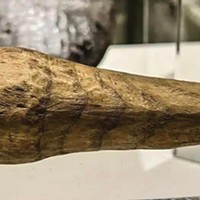[
{
"name": "Top Stories Video Pair",
"insertPoint": "7",
"component": "17087298",
"parentWrapperClass": "fdn-ads-inline-content-block",
"requiredCountToDisplay": "1"
}
]
Humboldt Bay (Wigi, to the Wiyot people) is actually a lagoon, the largest protected large body of water between San Francisco and Puget Sound. It's about 14 miles long and varies in width between a few hundred yards and 5 miles, with an area between 11 (low tide) and 24 (high tide) square miles. What follows is a selective timeline:
10,000 BC Rapid sea level rise as Earth enters a warming period following the last Ice Age, flooding a wide river valley that originally drained three rivers: Eel (cut off by Table Bluff during the Pleistocene), Mad (which cut its way to Pacific north of Humboldt Bay) and Elk (which still drains into Humboldt Bay).
5,000 BC The common Algic ancestor of what would become the Yurok and Soulatluk (Wiyot) languages was last spoken by Indigenous people living west of Lake Superior (or perhaps on the Columbian Plateau) before they migrated south and evolved separate and mutually unintelligible languages.
900 AD — or possibly hundreds of years earlier, Wiyot people arrive at Wigi, (again, in Soulatluk). They would establish about 100 villages on the shores of the bay.
1542-1775 Entrance to Humboldt Bay missed by many navigators, including Juan Rodriguez Cabrillo (Portuguese, first European to explore California); Francis Drake (English explorer and circumnavigator); Sebastián Vizcaíno (Spanish); George Vancouver (English); Alessandro Malaspina (Tuscan-Spanish); Bruno de Heceta and Juan Francisco de la Bodega y Quadra (who landed at Tsurai/Trinidad 1775).
1741 Vitus Bering, Danish navigator in service to the Russian Tsar Peter the Great, sails across what is now called the Bering Strait to Alaska, initiating Russian interest in North America.
1799 Russian-American Co. formed by Nikoli Rezanov, with the aim of promoting Russian commerce in Alaska and the west coast of North America, particularly the sea otter trade.
1803 Captain Jonathan Winship (from Massachusetts, part-owner of the 280-ton trading ship O'Cain) enters into a joint venture with Aleksandr Baranov (Russian governor of Alaska) to hunt sea otters (prized for their lush, silky fur), resulting in a successful voyage.
1806 Second voyage of the O'Cain sailing from New Archangel (later Sitka) with 100 Kodiak and Aleut hunters and their baidarkas (skin-covered kayaks). The ship anchored off North Spit in June, when the crew walked across the spit and "discovered" Humboldt Bay. The hunters in their baidarkas killed hundreds of sea otters within a week. The Russians mapped the lagoon, calling it Rezanov Bay on a chart published in St. Petersburg a year later, but kept it secret.
1841 Charles Wilkes, U.S. Navy captain, explored the coast between Coos Bay and San Francisco Bay, (lacking the Rezanov chart) concluding, "No ports exist ... it is an iron-bound shore."
1849 October-December, Josiah Gregg and seven others set out from near Helena to the Pacific, hoping to find an easy supply route for gold miners working the headwaters of the Trinity River. The six-week expedition was, according to L.K. Wood, "constant and unmitigated toil, hardship privation and suffering." They arrived at Wigi/Humboldt Bay from the north, having reached the Pacific near Little River. Gregg died on the return trip.
1850 April 9, schooner Laura Virgina enters what Captain Douglas Ottinger will name "Humboldt Bay" after the Prussian naturalist-explorer. Expulsion or enslavement of Wiyot people by Europeans begins.
1860 Feb. 26, the worst of many local massacres of Native people, at the Wiyot village of Tuluwat, when up to 200 mostly women and children were murdered during a World Renewal ceremony.
1972 U.S. Army Corps of Engineers placed 4,796 dolosse (singular: dolos), each weighing 42 tons, on the north and south jetties to prevent erosion. One more, No. 1972, is now at Madaket Plaza. (Another thousand were placed in 1983.)
2019 Oct. 21, the city of Eureka deeds all of its remaining land on Tuluwat Island to the Wiyot tribe.
Barry Evans (he/him, [email protected]) knows some of these mud flats intimately, having been stuck on them in his kayak.
Speaking of...
-

A Brief History of Dildos
Apr 11, 2024 -

Indigenous Foodways, Wind Farm Opposition and Big Boats
Mar 31, 2024 -

'Our Food is Our Medicine'
Mar 28, 2024 - More »
more from the author
-
Doubting Shakespeare, Part 1: Stratfordians vs. anti-Stratfordians
- Apr 25, 2024
-
A Brief History of Dildos
- Apr 11, 2024
-
Eclipse!
- Mar 28, 2024
- More »
Latest in Field Notes
Readers also liked…
-
Trouble on the Line: The Reality Part 2
- Nov 3, 2022

































